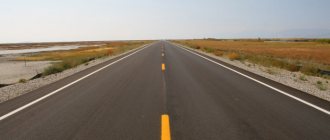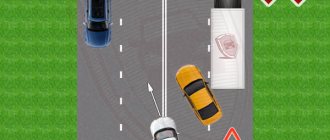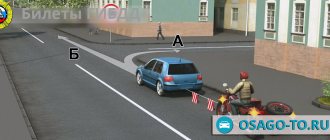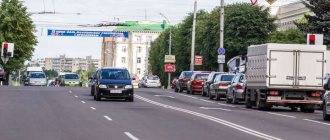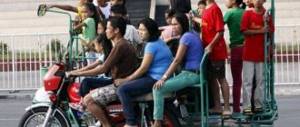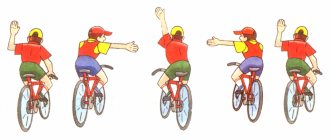It is an absolutely obvious fact that knowledge and compliance with road safety rules is a vital necessity for both pedestrians and drivers. The set of provisions specifies the basic requirements for all road users, including recommendations for driving a vehicle in various situations.
Dear readers! Our articles talk about typical ways to resolve legal issues, but each case is unique. If you want to find out how to solve your particular problem, please use the online consultant form on the right or call. It's fast and free!
Today we will discuss in more detail the algorithm for the movement of vehicles when changing lanes, analyze the most common mistakes made by drivers, and learn how to avoid emergency situations when performing this maneuver.
Rules for changing lanes on the road
The principles of moving a vehicle are reflected in Chapter 8 of the Regulations on Traffic Regulations of the Russian Federation:
- Clause 8.1. The road traffic regulations require that before starting to move or change lanes, the driver must give a light signal with the direction indicators about the direction of the car. During the maneuver, there should be no interference or danger for other road users.
- Clause 8.4. regulates that when moving from one road lane to another, the driver is obliged to give way to vehicles moving in the same direction, without changing its trajectory. If a situation arises when vehicles moving in the same direction simultaneously change lanes, the vehicle on the right has priority.
There are stages that can roughly be called an action plan for the driver when changing lanes:
- Objectively assess the situation on the road.
- Turn on the direction indicator lights.
- To control what is happening, you need to look in the rearview mirror.
- Change lanes and turn off the indicator lights.
It is important to understand that moving a vehicle from one lane to another requires objectivity, calculation and maximum attention from the driver to carry out the maneuver.
Road classification
The procedure for crossing the roadway
According to current legislation, the width of the road according to GOST must correspond to the type of road. This is a prerequisite for traffic safety. That is why, when accepting the road after marking has been completed, the dimensions must be measured to check their compliance with accepted standards.
At the rear of the rigid arm for use when working against the flow. For this purpose, a marking of 100 mm width is prescribed and is usually placed 50 mm from the rear of the rigid arm. It may remain when the opposite flow is removed or.
When measuring driving speed, for example. chicanes. The line should be laid with a clearance of approximately 225 mm to the central reservation. Where there is a solid strip, the edges should be laid as shown in the picture. They should be used on all highways in the positions shown in Figure 4. Inoperative studs also benefit from trade to keep them free of road grime and keep them functional. Except where experience shows that placing the studs on the roadway side of the edge line reduces their service life to unacceptable levels, this may be better than placing them behind the line.
The width of the road according to GOST in a populated area depends on which particular highway was laid. The following types are distinguished:
- 4/8 lane (both directions) highways for high-speed traffic (up to 130 km/h);
- Similar urban highways (with a maximum permissible speed of 100 km/h);
- 2/6 lane (both directions) main roads (speed limit – no higher than 80 km/s, traffic flow – regulated);
- City roads with similar speed limits and traffic flow regulation (4 – 8 lanes);
- 2/4-lane transport and pedestrian roads with mandatory presence of a shoulder (value – regional, permissible speed – 70 km/h);
- Streets/passages for access to production and/or transport enterprises (for the movement of large vehicles);
- Regular roads with the minimum width allowed by the rules: secondary roads to remote settlements, auxiliary driveways and street driveways in residential areas.
The rules regulate the width of the road right of way, the size of the dividing strip and other parameters significant for traffic.
Further instructions on the use of road studs are given in the section. They consist of a continuous line marking with edges across the line at regular intervals. The vertical edges of the raised fins extend beyond the water film in wet conditions, improving the reflective performance of headlights.
The fins also provide an audible vibration warning to drivers if they veer off the roadway and run toward the markings. The base marking should be no more than 6 mm. The top of the ribs above the base marking shall not exceed 11 mm for a 2 chart and 8 mm for a chart. A spacing of 500mm is suitable for most edge lines installed on the main carriageway. On motorways, a distance of 250 mm is recommended for slip roads. The closer distance helps maintain the rumble effect, compensating for the likely lower speed.
Simultaneous lane change
Often, for various reasons - some due to inexperience, some due to excessive self-confidence in personal driving experience, do not properly perceive the fact that the main problem when changing lanes is to adequately assess what is happening on the road.
It should be noted that the Traffic Rules regulate cases in which changing lanes is legally justified, these are:
- left turn;
- right turn;
- reversal This maneuver must be carried out while approaching the intersection in order to make a U-turn from the permitted lane.
In addition, in paragraph 8.4 of the traffic rules, we have already discussed this provision earlier, the principles of simultaneous lane changes are indicated.
Now we will look at several options for simultaneously changing lanes, which are quite common in everyday life:
- You enter the lane on the left. A vehicle from the left lane is also trying to change lanes. In this case, the car is obliged to give way to you; the “right hand” rule applies here. However, you should not lose your vigilance and rush headlong, you need to make sure that they really let you through and only then carry out the maneuver.
- You move to the lane that is on your right. The driver of the car in the right lane also changes lanes. In this case, you must give way.
Are you allowed to take the lead in this situation while driving a truck?
| 1. | Yes, if the permissible maximum weight of your car is less than 2.5 tons. |
| 2. | Yes, regardless of the maximum permissible weight of your vehicle. |
| 3. | No. |
On all roads with three or more lanes for traffic in one direction, trucks with a permissible maximum weight of more than 2.5 tons are allowed to enter the leftmost lane only for turning left and making a U-turn. That is, you can drive into the leftmost lane to get ahead only if the permissible maximum weight of your car is less than 2.5 tons.
Changing lanes in traffic
Unfortunately, some drivers assume that when changing lanes, only dense traffic flow is dangerous. This is a misconception. The fact is that driving on roads with low traffic volume dulls concentration, which runs the risk of not being able to see a vehicle in the blind spot in time, or not noticing a moving motorcycle.
The dead zone is a rather dangerous “phenomenon”, which represents a situation when the vehicle has already disappeared from the view of the side rear mirror, but has not yet appeared in the window.
To neutralize the negative influence of the dead zone, it is important to correctly adjust the view of the rear view mirror.
You should also pay special attention to the fact that you should not change several lanes at once. This can provoke a serious traffic accident, since the driver is unlikely to be able to adequately assess what is happening. The restructuring must take place in stages.
Geometric dimensions of the roadway and pedestrian crossings FD 2 - width of the roadway
Why is driving on the side of the road dangerous?
Domestic and foreign experience in statistical analysis of accident rates indicates the significant impact that the main elements of the transverse profile of roads have on traffic safety. Such elements, first of all, include the width of the roadway and traffic lanes, the number of traffic lanes, the width of the shoulders, and the width of the dividing strip. The more lanes there are on the highway, the more difficult it is for pedestrians to cross the roadway at an unregulated pedestrian crossing and the greater the risk of a traffic accident. One of the main reasons for collisions with pedestrians is the use of unregulated pedestrian crossings on multi-lane roads, which do not allow drivers in the second and third lanes to see a pedestrian crossing a zebra crossing. The presence of an unregulated pedestrian crossing on a multi-lane highway, combined with high intensity of pedestrian flows, especially in the immediate vicinity of objects of attraction for transport and pedestrians, significantly aggravates the road situation, which sharply increases the risk of a traffic accident involving pedestrians.
To reduce accident rates in these areas, it is recommended to abandon unregulated pedestrian crossings on multi-lane roads, where the majority of collisions with pedestrians occur (due to the fact that drivers moving in the left lanes do not see the pedestrian behind a car moving in the right lane of the road), replacing them with controlled pedestrian crossings.
The absence or poor visibility of road markings on multi-lane highways further aggravates the traffic situation, leading to drivers moving with less lateral spacing from each other, which often leads to the fact that when there are 3 lanes for traffic, drivers can move in 4 or even 5 streams, which further increases the risk of accidents if there are uncontrolled pedestrian crossings on such sections of the roadway.
FO 3 - width of the pedestrian crossing, lack of markings or poor visibility.
By definition, a pedestrian crossing is a section of the roadway, indicated by appropriate road signs and (or) markings, and allocated for the movement of pedestrians across the road. Thus, the rules allow pedestrians to cross the roadway mainly in places designated by special technical means of organizing traffic. Compliance with this rule is the key to ensuring the safety of pedestrians. The order of movement depends on the method of organizing movement chosen in each specific case. Ground pedestrian crossings can be regulated or unregulated. Regardless of the type of crossing, they must be marked with appropriate signs and (or) markings.
To indicate a pedestrian crossing, signs 5.19.1 and 5.19.2 “Pedestrian Crossing” are used, which, according to GOST R 52289 -2004, are placed at the borders of the crossing on each side. In this case, sign 5.19.1 is installed to the right of the road, and sign 5.19.2 to the left.
Rice.
If there are markings, the width of the pedestrian crossing is determined by the boundaries of the marked section of the roadway. In turn, the width of the marked area depends on the intensity of pedestrian traffic (clause 6.2.17 of GOST R 52289-2004). When the width of the pedestrian crossing is from 4 to 6 m, marking 1.14.1 is used, with a larger width – marking 1.14.2. In the latter case, when crossing the roadway, pedestrians should be guided by the direction of the arrows. GOST R 51256-99 does not provide for the use of any other markings for pedestrian crossings other than 1.14.1 and 1.14.2. When crossing the roadway, pedestrians must walk within the width of the crossing.
The rules allow, in the absence of marked pedestrian crossings, to cross the road at intersections along sidewalks or curbs, unless, of course, fences are installed in these places to prevent crossing. The width of the roadway strip that can be used by pedestrians to cross the road at an intersection in the absence of pedestrian crossings is determined by the width of the corresponding sidewalks or shoulders. Thus, it is prohibited to drive diagonally at the intersection or along any other path that goes beyond the designated lane. The width of the marked pedestrian crossing is determined by the intensity of pedestrian traffic at the rate of 1 m for every 500 pedestrians/hour, but not less than 4 m.
Insufficient visibility or absence of road markings at pedestrian crossings increases the risk of a traffic accident.
Changing lanes in the ring
Roundabouts are quite common in populated areas. The purpose of their creation was to make it easier to cross the road and avoid delays in traffic. But these rules only work at average traffic intensity, when the number of vehicles on the road increases significantly, traffic jams begin and the number of accidents sharply increases.
The most important thing to remember is that the rules for changing lanes in a traffic circle are absolutely identical to the principles for changing lanes on a straight road. The only caveat is leaving the ring. This maneuver must be carried out from the far right lane, but in no case from the left.
How to avoid accidents when changing lanes?
There are certain rules that must be followed to avoid serious mistakes, because they, in turn, can lead to serious vehicle accidents:
- If there is no vehicle in the rear-view mirrors, you need to look out the side windows of the car. How to carry out this manipulation so that control over the control of the machine is in no case lost, and moreover, if an emergency situation arises, there is time to react and make the right decision.
- When driving in heavy traffic, you need to be able to use “pockets”. This is the distance between closely moving vehicles, with which you can maneuver.
- When changing lanes into an adjacent lane, you need to adequately assess the speed of the vehicle towards which you plan to move.
- If you are maneuvering into a lane where the average traffic speed is higher than yours, there is a need to move with empathy.
To summarize, it should be noted the need to comply not only with basic norms and rules of behavior on the road, but also with the principles of changing a vehicle lane in certain situations. We must not forget that, according to statistics, the number of accidents when changing lanes is much higher than during other types of maneuvering.
Remember that you need to be not only a law-abiding driver, but at the same time remain a Person who respects other road users. If everyone tries to behave accordingly, then the number of traffic jams and accidents on the roads will certainly decrease.
Didn't find the answer to your question? Find out how to solve exactly your problem - call right now: +7 (Moscow) +7 (812) 309-53-42 (St. Petersburg) It's fast and free!
Free online consultation with a car lawyer
Didn't find the answer to your question? Find out how to solve exactly your problem - call right now: +7 (Moscow) +7 (812) 309-53-42 (St. Petersburg) It's fast and free!
Violations
A fine and other types of punishment are provided for violation of traffic rules for driving in lanes. In case of crossing a solid line marking, and even more so when crossing a double solid line, the driver’s license will be revoked for a period of 6 months. The most severe traffic violation is driving into oncoming traffic. In case of such a violation, you will have to forget about your driver’s license.
On the Samp RP server and on some other popular projects you just need to pay money and then carefully drive around the city of SF (in which the driving school is located).
On Advance RP there is a license test that costs $600. So, the answers:
- What does M stand for? – Engine turned on .
- Headlight key? – Left Alt .
- City limit? – 50.
- How to refuel? – Num 2 .
- How to turn on the engine? – Left Ctrl .
- Fuel 45? – There is 45 gasoline in the gas tank .
- Reduce consumption? – Turn off the engine .
- Open/close the house. car? – Right Ctrl.
- Full gas tank? – 50 minutes .
- Limiter? – Num 4 .
- E? - Not enough gasoline .
- Siren? - There is no correct one .
There is also a test on the GameWorld server. Here are the answers (the order may not be the same, since random is used when issuing questions):
- Which side of the road is traffic allowed on? - On the right.
- A car overtakes you. Your actions? – Do not interfere with overtaking.
- Maximum speed in a populated area? – 60 km/h.
- Maximum speed outside populated areas? – Num 2.
- A police car with its emergency lights on is approaching from behind. Your actions? – Will stop on the side of the road if the car is not overtaking.
- How to start the engine? – Alt key.
- Is the driver breaking the rules by driving in the middle of the road? - Violates in any case.
- How to turn on the headlights? – Ctrl.
- What to do if the oil in your car is expired? – Change the oil at the Los Santos car service center.
- What does the E indicator mean when the panel is on? – Motor condition.
There is also a test for Galaxy-RPG. Answers:
- What does a flashing green traffic light mean? — Allows movement and informs...
- What should be decisive for you when choosing your speed at night? — Visibility conditions.
- Are you allowed to drive at too low a speed? — It is allowed if you do not interfere with other vehicles.
- What does a flashing yellow traffic light mean? — Allows movement and informs...
- Is the driver of the overtaken vehicle obliged? — Move at the same or lower speed.
- What does the combination of red and yellow traffic lights mean? — The green signal will be turned on soon.
- Drivers and passengers of which vehicles must wear seat belts when driving? — All vehicles equipped with seat belts.
But on the Diamond RP there are two tests - when passing the license and when obtaining an aircraft license. Please note that when you take the first test, the questions are randomized. There are 25 questions in total, of which five are dropped.
- When is overtaking a vehicle in front allowed? — In the absence of an obvious threat of collision.
- When you see a vehicle with special equipment turned on. Is the driver required to signal? — Gradually reduce speed and pull to the side of the road.
- What should you do first when an accident occurs? — Stay where you are and call the software staff.
- When can you turn on high beam headlights in the city? - On the road.
- Is overtaking allowed when there is a double solid line? - Forbidden.
- What is the maximum speed of a vehicle on a highway? — 150 km/h.
- What is the maximum speed of a vehicle in the suburbs? — 110 km/h.
- What is the maximum speed of a vehicle in the city? — 60 km/h.
- Is it legal to overtake vehicles in front of you in the city? — Allowed if there is no threat of collision.
- When should you wear a seat belt? - Anyway.
- Is reversing allowed on the highway? - No, not allowed.
- In what place does the driver have the right to park? - In the parking lot.
- Is it worth observing the load capacity of the tractor? - Yes, always.
- Is it necessary to look in the rearview mirrors when reversing? - Necessarily.
- What type of intersections are there in the state? — Unregulated equivalent roads.
- Is it possible to install special signal for a personal car? - No you can not.
- At what age can you get water? rights? - From the age of 18.
- What is a traffic accident? — Road traffic accident.
- What should a driver do when crossing an intersection? — Reduce speed and drive through in the absence of obstacles.
- In what cases is overtaking on the right allowed? — Allowed if the vehicle in front is turning.
- When should an alarm be activated? - In case of an accident.
- Should government officials be visible? car number? - Must be in front and behind.
- Is overtaking on broken lines allowed? - Always allowed.
- Is it mandatory to stop before a pedestrian crossing? - Mandatory.
- Is it allowed to turn a vehicle around in a tunnel? - No.
Here are the answers when passing for air. Please note that you can only obtain a license after several years in the state.
- At what age are you allowed to fly an aircraft? - 18 years.
- Operating an aircraft while under the influence of drugs or alcohol? - It is prohibited.
- What is prohibited when operating air transport? — Talk on the phone and be distracted from control.
- What should you do when approaching another aircraft? — Move 30 degrees to the right.
- Speed limit for air transport? - Absent.
- Limiting the altitude of air transport? - Absent.
- Flying over military bases for civilians? - Prohibited.
- Performing aerobatic maneuvers? — Allowed from 21 years of age.
We didn’t forget about the test on the Stage RP server:
- On which side is overtaking a vehicle allowed? - Allowed on the left side.
- On what part of the road is traffic allowed? — In the right lane.
- What actions are prohibited if you are being overtaken? - Both actions.
- Maximum speed for driving in a residential area? — 60 km/h.
- Maximum speed in a populated area? — 90 km/h.
- Maximum speed outside a populated area? — 150 km/h.
- Which of the following actions can be considered overtaking? — With driving into oncoming traffic.
- When driving a vehicle with a flashing light on, is it necessary? - Give way and ensure unobstructed passage.
- In which of the following places is a U-turn not permitted? - At crossroads.
- Boarding/disembarking passengers from the side of the roadway? - Forbidden.
